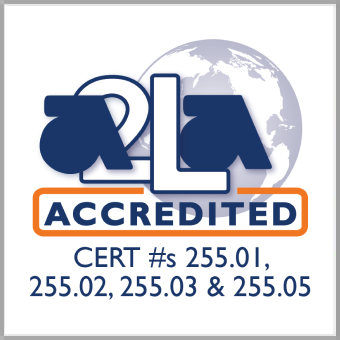Assessment of Resistance of Medical Gloves to Permeation by Chemotherapy Drugs
Standard Practice for Assessment of Resistance of Medical Gloves to Permeation by Chemotherapy Drugs
ASTM D 6978
ASTM D5712 (Modified Lowry Assay)
ASTM D5712 (Modified Lowry Assay) is a chemical method used to quantify the total extractable protein content of a test item. This method is not specific for latex proteins but will determine the total amount of protein from Hevea brasiliensis and other sources that are present on the test item. NOTE: For this assay, a minimum three items (e.g., gloves) are required for a single test result. ARDL is also accredited for CEN455-3, which is the European Standard equivalent of the ASTM D5712. NOTE: For the CEN procedure, at least 4 gloves are required for testing.
ASTM D5712
Detection of Holes in Medical Gloves
Standard Test Method for Detection of Holes in Medical Gloves
ASTM D 5151
Determination of Resistance to Permeation by Chemicals
Determination of Resistance to Permeation by Chemicals - Resistance to Permeation Is Assessed by Measuring The Time For a Chemical to Breakthrough The Glove Material. Samples, Cut From The Palms of Gloves, are placed in a permeation cell which enables the chemical to be placed in contact with the outer surface of the gloves. Collection air or water is passed through the cell to collect any chemical that has broken through to the inside surface of the glove sample. ARDL's Chemical, Pharmaceutical & Microbiological Services laboratory is equipped with a FTIR spectrometer (to detect solvents), conductivity/pH electrodes (to detect acids, alkalis and salts) and UV/Visible spectrophotometer (to detect high boiling point, water soluble chemicals and solvents).
To carry the chemical pictogram, products must now meet at least level 2 of EN 374-2 as well as a performance level 2 when tested against three of the following chemicals: Acetone, Acetonitrile, Carbon Disulphide, Diethylamine, Ethyl Acetate, Methanol, n-Heptane, Sodium Hydroxide, Sulphuric Acid (96%), Tetrahydrofuran, Toluene.
EN 374-3
Determination of Resistance to Permeation by Chemicals
Determination of Resistance to Permeation by Chemicals - Resistance to Permeation Is Assessed by Measuring The Time For a Chemical to Breakthrough The Glove Material. Samples, Cut From The Palms of Gloves, are placed in a permeation cell which enables the chemical to be placed in contact with the outer surface of the gloves. Collection air or water is passed through the cell to collect any chemical that has broken through to the inside surface of the glove sample. ARDL's Chemical, Pharmaceutical & Microbiological Services laboratory is equipped with a FTIR spectrometer (to detect solvents), conductivity/pH electrodes (to detect acids, alkalis and salts) and UV/Visible spectrophotometer (to detect high boiling point, water soluble chemicals and solvents).
To carry the chemical pictogram, products must now meet at least level 2 of EN 374-2 as well as a performance level 2 when tested against three of the following chemicals: Acetone, Acetonitrile, Carbon Disulphide, Diethylamine, Ethyl Acetate, Methanol, n-Heptane, Sodium Hydroxide, Sulphuric Acid (96%), Tetrahydrofuran, Toluene.
EN 374-3
Determination of Resistance to Water Penetration
Determination of Resistance to Water Penetration
This is the reference test specified by the European Standard for the assessment of glove quality. Gloves must pass this test in order to prove that they are an effective barrier against liquids and micro-organisms. A statistical sample taken from a batch of gloves is subject to checks for pinholes and leaks by either inflation with air or by filling with water. Performance levels are assessed according to the acceptable quality levels (AQL) of the gloves.
Gloves must meet at least level 2 of EN374-2 to be considered micro-organism resistant.
EN 374-2
Disposable Embalming Gloves for Single-Use applications – Antigenic Protein
Disposable Emblaming Gloves for Single-Use Applications - Antigenic Protein
ASTM D 7198
Disposable Embalming Gloves for Single-Use applications – Extractable Protein
Disposable Emblaming Gloves for Single-Use Applications - Extractable Protein
ASTM D 7198
Disposable Embalming Gloves for Single-Use applications – Extractable Protein
Disposable Emblaming Gloves for Single-Use Applications - Extractable Protein
ASTM D 7198
Disposable Embalming Gloves for Single-Use applications – Extractable Protein
Disposable Emblaming Gloves for Single-Use Applications - Extractable Protein
ASTM D 7198
FDA Leakage Standard for Latex Gloves
FDA Leakage Standard for Latex Gloves
US 21-CFR 800.20
Poly(vinyl chloride) Gloves for Medical Application Testing
Standard Specification for Poly(vinyl chloride) Gloves for Medical Application
ASTM D 5250
Puncture Resistance of Protective Clothing Material – Procedure A
Standard Test Method for Protective Clothing Material Resistance to Puncture
ASTM F 1342 Procedure A
Residual Powder on Medical Gloves Testing
Standard Test Method for Residual Powder on Medical Gloves
ASTM D 6124
Rubber Examination Gloves Testing
Standard Specification for Rubber Examination Gloves
ASTM D 3578
Rubber Surgical Gloves (US Pharmacopeia) Testing
Standard Specification for Rubber Surgical Gloves (US Pharmacopeia)
ASTM D 3577



